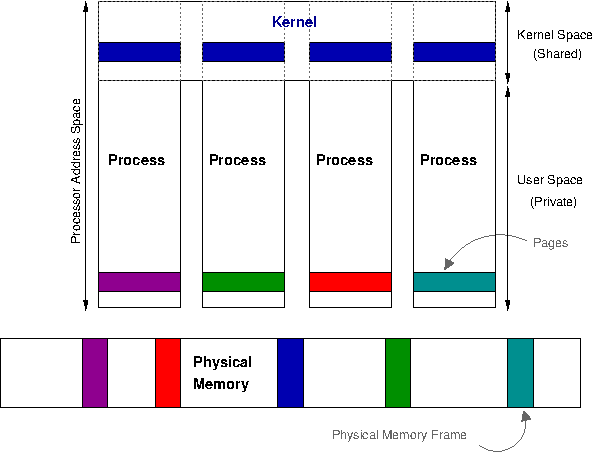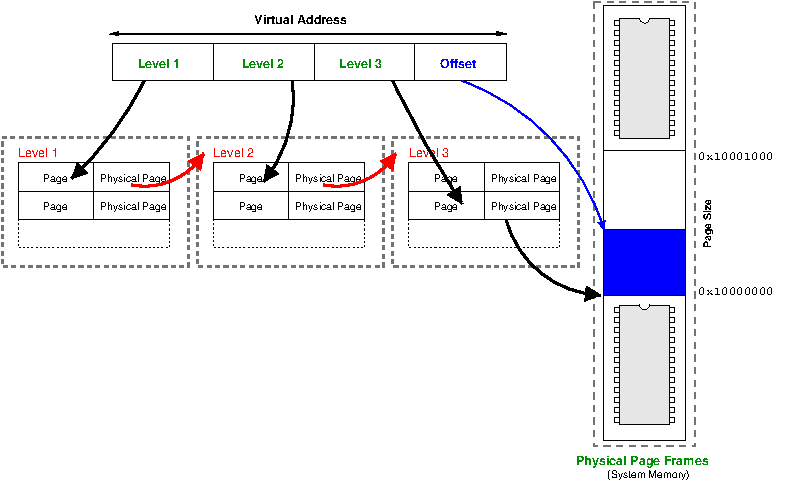An introduction to Linux Virtual Address Space Layout
来源:互联网 发布:centos www服务器配置 编辑:程序博客网 时间:2024/05/22 15:21
(This is an introduction for the virtual address space layout I found in a web and there are also the other serious of operating system. And this is useful for those who are studying paging tech of operating system. For more information, you click at the following link:http://www.bottomupcs.com/virtual_memory_linux.html) Or another link:http://www.tldp.org/LDP/tlk/mm/memory.html But you have to keep in mind that the "VPFN" in the picture means "virtual page frame No."
http://stackoverflow.com/questions/3552633/in-virtual-memory-can-two-different-processes-have-the-same-address
Theoretically every process executed by user in any present popular OSes(Win,linux,unix,Sol etc) are initially allowed to use the address range of 4gig ( 0x00000000 t0 0xffffffff on 32 bit platform),whether its a simple hello world program or its complex web container hosting stackoverflow site.It means every process has its range starting from the same start address and ending with the same address space VIRTUALLY. So obviously every process has that same virtual addresses in their respective virtual address space range. So answer for your first question is YES.
Difference comes when OS execute any process, modern OSes are multitasking OS and they run more then on process at any point of time.So accommodating 4gig of every process in the main memory is not feasible at all. So OSes using paging system,in which they divide the virtual address range (0x00000000 to 0xffffffff) into a page of 4k size(not always). So before starting the process it actually load the required pages which needed at the initial time to the main memory and then load the another virtual page ranges as required. So loading of virtual memory to physical memory (main memory) is called memory mapping. In this process you map the page's virtual address range to physical address range( like ox00000000 to ox00001000 virtaul address range to 0x00300000 to 0x00301000 physical address range)based on the slot free in the main memory.So at any point of time only one virtual address range will be mapped to that particular physical address range,so answer for your second question is NO.
2.Linux Specifics(http://www.bottomupcs.com/virtual_memory_linux.html)
Although the basic concepts of virtual memory remain constant, the specifics of implementations are highly dependent on the operating system and hardware.
Address Space Layout
Linux divides the available address space up into a shared kernel component and private user space addresses. This means that addresses in the kernel port of the address space map to the same physical memory for each process, whilst userspace addresses are private to the process. On Linux, the shared kernel space is at the very top of the available address space. On the most common processor, the 32 bit x86, this split happens at the 3GB point. As 32 bits can map a maximum of 4GB, this leaves the top 1GB for the shared kernel region[20].

Three Level Page Table
There are many different ways for an operating system to organise the page tables but Linux chooses to use a hierarchical system.
As the page tables use a heirarchy that is three levels deep, the Linux scheme is most commonly referred to as the three level page table. The three level page table has proven to be robust choice, although it is not without it's criticism. The details of the virtual memory implementation of each processor vary widley meaning that the generic page table Linux chooses must be portable and relatively generic.
The concept of the three level page table is not difficult. We already know that a virtual address consists of a page number and an offset in the physical memory page. In a three level page table, the virtual address is further split up into a number levels.
Each level is a page table of it's own right; i.e. it maps a page number of a physical page. In a single level page table the "level 1" entry would directly map to the physical frame. In the multilevel version each of the upper levels gives the address of the physical memory frame holding the next lower levels page table.

So a sample reference involves going to the top level page table, finding the physical frame that the next level address is on, reading that levels table and finding the physical frame that the next levels page table lives on, and so on.
At first, this model seems to be needlessly complex. The main reason this model is implemented is for size considerations. Imagine the theoretical situation of a process with only one single page mapped right near the end of it's virtual address space. We said before that the page table entry is found as an offset from the page table base register, so the page table needs to be a contiguous array in memory. So the single page near the end of the address space requires the entire array, which might take up considerable space (many, many physical pages of memory).
In a three level system, the first level is only one physical frame of memory. This maps to a second level, which is again only a single frame of memory, and again with the third. Consequently, the three level system reduces the number of pages required to only a fraction of those required for the single level system.
There are obvious disadvantages to the system. Looking up a single address takes more references, which can be expensive. Linux understands that this system may not be appropriate on many different types of processor, so each architecture can collapse the page table to have less levels easily (for example, the most common architecture, the x86, only uses a two level system in its implementation).
- An introduction to Linux Virtual Address Space Layout
- [windows_internals]Memory Layout (Virtual address space of a C process) under Linux OS
- Memory Layout (Virtual address space of a C process)
- Virtual address space for Linux process
- virtual address space
- Virtual Address Space (Windows)
- How to modify virtual address space in Windows
- An Introduction to Hardware-Assisted Virtual Machine (HVM) Rootkits
- An Introduction to Struts
- An introduction to LaTeX2e
- An Introduction To Ajax
- An introduction to SOA
- An introduction to Microcode
- An Introduction to LDAP
- An Introduction To SQLite
- An Introduction to Libaio
- An Introduction to LDAP
- An Introduction to GCC
- 黑马程序员———基本数据类型对象包装类
- 机房收费系统合作版——VS2013自带报表
- HIVE 0.14.0安装
- 百灵面试
- 杭电1233还是畅通工程
- An introduction to Linux Virtual Address Space Layout
- Android ListView加载头视图后容易忽略的问题
- 解决关于request.getremoteaddr()方法返回的内容是ipv6的问题
- 4、黑马程序员-C语言内存分析
- explain -- explaining away
- list中对象去重
- 树形结构的数据库表Schema设计
- unity3D---枚举函数
- memcache && redis 基础


